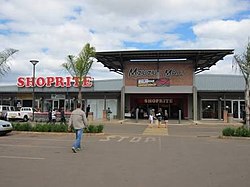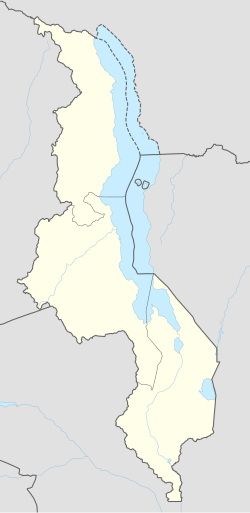Mzimba District
Mzimba | |
|---|---|
District | |
 Mzuzu Shoprite Centre Opposite Katoto Filling Station in Mzimba District | |
| Coordinates: 11°30′S 33°30′E / 11.500°S 33.500°E | |
| Country | Malawi |
| Region | Northern Region |
| Capital | Mzimba |
| Established | 1908 |
| Government | |
| • Type | Unitary presidential republic |
| Area | |
| • Total | 10,473 km2 (4,044 sq mi) |
| Population (2023[2]) | |
| • Total | 1,017,701[1] |
| Racial makeup (2023) | |
| • Black African | 94.1% |
| • Asian | 2.6% |
| • Mixed | 1.9% |
| • White | 1.3% |
| • Other | 0.1% |
| First languages (2018) | |
| • Chitumbuka | 93.2% |
| • Chichewa | 2.8% |
| • Yao | 1.5% |
| • Lomwe | 1.1% |
| • English | 0.2% |
| • Other | 1.1% |
| Time zone | UTC+2 (CAT) |
| ISO 3166 code | MW-MZ |
Mzimba is a district in the Northern Region of Malawi. The capital is Mzimba and the biggest town is Mzuzu, which is also the administrative headquarters of the Northern Region. The district covers an area of 10,473 km2 and has a population of 1,017,701 (2023).[3] It is the largest district in Malawi. The district is inhabited by descendants of Tumbuka and few Ngoni people who also speak Tumbuka as the Ngoni language is extinct. Tumbuka is the predominant language spoken in the district.[3]
History
[edit]Pre-colonial era
[edit]In the late 15th century, the Zwangendaba Ngonis that fled from South Africa settled in northern Malawi. However, once the Zwangendaba head of the family died, his sons resettled to what is now the Mzimba District and seven of his descendants still rule.[4] The current king of the district is King Mmbelwa V.[5][6]
Establishment
[edit]
The district was established in 1908 by the British colonial administration as a key administrative center. Prior to its establishment, the region was ruled by Inkosi Chimtunga, the leader of the Ngoni people, from 1896 to 1915. Chimtunga resisted British efforts to recruit the Mzimba people into the British Army during World War I and was subsequently deposed in 1915. The British colonial administration solidified their control over the region, establishing Mzimba as a major administrative center. However, the town of Mzimba began to decline in importance in the 1940s, and the administrative center was eventually moved to Mzuzu. In 2008, the Centenary Celebrations of the establishment of Mzimba district were held at Hora Mountain in Mzimba district in Malawi.
Call for district split
[edit]In 2016, there were calls to split the district into three, but the head ruler was not in favor of it.[7] The reasons behind for the call were its geographical size as it is the largest district in Malawi, covering an area of 10,473 km2. Some residents felt that the district was too large and difficult to manage effectively. The other reason for the call of split was its population growth as district's population had grown significantly, leading to increased demands for services such as healthcare, education, and infrastructure. Residents and other authorities felt that splitting the district would allow for more efficient delivery of the services. The other reason was the district's political representation as some residents felt that the district's large size and population meant that certain areas were not receiving adequate political representation.[7]
The call to split the district was led by several traditional leaders and kings, including Chief Mzukuzuku and Chief Mtwalo, who argued that the district was too large and difficult to manage. The chiefs and kings proposed that the district be split into three smaller districts which were to be Mzimba North, Mzimba Central, and Mzimba South. However, the call to split the district was not fully supported by everyone as some natives and stakeholders, including the district's Member of Parliament, argued that about splitting as it would lead to unnecessary administrative costs and duplication of services. In the end, the proposal to split the district into three separate districts was not implemented. The Malawi government decided not to proceed with the split, citing concerns about the potential costs and logistical challenges that could be involved.[7]
The final decision was made by the Malawi government, in consultation with relevant stakeholders, including traditional leaders, natives, and the district's Member of Parliament. The government decided to maintain the status quo and keep the district intact, with a commitment to improving service delivery and representation in the district.[7]
Geography
[edit]The district's diverse landscape features the Viphya Mountains that stretch across its southern and eastern regions, while the central area is occupied by the Mzimba Plain. The South Rukuru River and its tributaries flow through the plain, draining into the nearby basin. The district's western border shares a boundary with Zambia, marked by a low divide separating the South Rukuru basin from the Luangwa River basin.[8]
Government
[edit]Since 2009, there are twelve National Assembly constituencies in Mzimba:[8]
Divisions
[edit]The district is divided into 13 sub-divisions, each with its characteristics. These include SC Jaravikuba Munthali, Vwaza Marsh Game Reserve, TA Mpherembe, TA Mtwalo, Mzuzu City, TA Chindi, SC Kampingo Sibande, Mzimba Boma, TA M'Mbelwa, TA Mzikubola, TA Mzukuzuku, SC Khosolo Gwaza Jere, and TA Mabulabo.[8]
Economy
[edit]Mzimba's economy is diverse and growing, with various sectors contributing to its development.
Agriculture
[edit]The mainstay of Mzimba's economy is agriculture that employs most of the population. Key crops implemented in the area include tobacco (main cash crop), maize, groundnuts, and beans. Other crops such as cassava, sweet potatoes, and vegetables are planted in the area.
Forestry
[edit]The district has significant forest reserves, with timber production and wood processing contributing to the economy. One of its forest reserves include Chikangawa Forest Reserve.
Mining
[edit]Mzimba has deposits of minerals such as uranium, coal, bauxite and graphite, as well as granite.
Manufacturing
[edit]The district has many small-scale industries such as food processing with services of tobacco curing, oil seed crushing. Others include textiles companies that gin cotton, as well as garment production including wood products (such as furniture, carpentry).
Tourism
[edit]Mzimba's natural attractions include the Viphya Mountains and Vwaza Marsh Game Reserve, among others that offer opportunities for eco-tourism, wildlife conservation and cultural tourism.[3]
Demographics
[edit]At the time of the 2018 Census of Malawi, the distribution of the population of Mzimba District by ethnic group was as follows: 78.3% Tumbuka, 9.1% Chewa, 6.3% Ngoni, 1.4% Lomwe, 1.1% Yao, 1.0% Tonga, 0.9% Sukwa, 0.4% Lambya, 0.3% Nkhonde, 0.1% Sena, 0.1% Mang'anja, 0.1% Nyanja and 0.8% others.
Cities in Mzimba District
[edit]Culture
[edit]The district consists of people of Tumbuka with their Cultural Dance (Vimbuza) origin. And also, descendants of Ngoni people from South Africa with their Cultural Dance (Ingoma). However, the main language spoken is chiTumbuka. The district headquarters is at Mzimba. It is also the centre of netball in Malawi, Malawi's most successful sport. Most of the players in the national team, including international star Mwayi Kumwenda were born and grew up in Mzimba.[9]
Famous people
[edit]- Mwayi Kumwenda (1989–), a netball player for the Malawi national team.
- Goodall Gondwe, former Minister of Finance of Malawi
- Rose Chibambo, Malawian politician
- Jane Chimaliro, a netball player for the Malawi national team.
- Tamika Mkandawire, former professional footballer
- Brighton Munthali, a Malawian professional footballer
- Towera Vinkhumbo, a netball player for the Malawi national team
- Bridget Kumwenda, a netball player for the Malawi national team
Incidents
[edit]
On 10 June 2024, a Malawian Defence Force Dornier 228 carrying Vice-President of Malawi Saulos Chilima, former First Lady Patricia Shanil Muluzi, and seven other occupants, crashed in Chikangawa Forest Reserve in Nkhata Bay District; all on board died.
At the time of the crash, the aircraft and its passengers were en route from Lilongwe to Mzuzu Airport in the Northern Region to attend a funeral.[10][11]See also
[edit]References
[edit]- ^ "Mzimba (District, Malawi) - Population Statistics, Charts, Map and Location". www.citypopulation.de. Retrieved 2024-06-13.
- ^ "Mzimba (District, Malawi) - Population Statistics, Charts, Map and Location". www.citypopulation.de. Retrieved 2024-06-13.
- ^ a b c "Mzimba (District, Malawi) - Population Statistics, Charts, Map and Location".
- ^ Qeko, Dr (2011-02-14). "REV DR QEKO JELE: MZIMBA AND THE NGUNI KINGDOM IN MALAWI". REV DR QEKO JELE. Retrieved 2016-11-16.
- ^ "Inkosi M'mbelwa preaches peace through sports - Malawi Nyasa Times - News from Malawi about Malawi". www.nyasatimes.com. 2024-05-06. Retrieved 2024-06-13.
- ^ Reporter, Malawi24 (2018-03-25). "M'mbelwa warns farmers against selling farm produce Malawi 24 | Latest News from Malawi". Malawi 24. Retrieved 2024-06-13.
{{cite web}}: CS1 maint: numeric names: authors list (link) - ^ a b c d "Calls to divide Mzimba have re-emerged: MP Dimba says by splitting biggest district can solve some of the problems - Malawi Nyasa Times - News from Malawi about Malawi". www.nyasatimes.com. 2017-01-13. Retrieved 2024-06-13.
- ^ a b c "Mzimba". npc.mw. Retrieved 2024-06-13.
- ^ "Mzimba|All About Malawi". All About Malawi (in Japanese). Retrieved 2020-05-27.
- ^ Gondwe, Gregory and Imray, Gerald (11 June 2024). "Malawi's vice president and 9 others are confirmed dead after their plane's wreckage is found". Associated Press. Archived from the original on 11 June 2024. Retrieved 11 June 2024.
- ^ "UTM Raises Transparency Concerns Over Missing VP's Plane". AfricaBrief. 2024-06-11. Retrieved 2024-06-21.



